Racist Incidents Recorded by the Police in Scotland, 2013-14
This bulletin presents statistics on racist incidents recorded by Police Scotland in 2013-14.
Racist incidents reported to the police may involve one or more victims/ complainers, one or more perpetrators, and may result in one or more crimes or offences being recorded.
3. Main Findings: Racist Incidents Recorded by the Police in Scotland
3.1. Incidents Recorded by the Police
In 2013-14, a total of 4,807 racist incidents were recorded by the police in Scotland, a 3.9% increase on the 4,628 racist incidents recorded in 2012-13 (Chart 1 & Table 1).
It should be noted that there are a number of factors over the years that may have influenced the number of racist incidents recorded by the police. One factor is that police forces are continuing to work with a range of victim support agencies to encourage reporting of such incidents. Other factors may be an increasing public intolerance of such behaviour, and increased public confidence that reporting such incidents is worthwhile.
Sixteen of Scotland's 32 local authorities recorded an increase in the number of racist incidents between 2012-13 and 2013-14, two recorded the same number of incidents and 14 recorded a decrease (Table 1).
In 2013-14, the number of racist incidents recorded per 10,000 population was highest in Glasgow City (20.7 incidents per 10,000 population) and City of Edinburgh (19.2 incidents per 10,000 population) (Chart 2 & Table 2).
Whilst the City of Edinburgh and Glasgow City collectively account for 20.4% of Scotland's population, 45.1% of all racist incidents recorded in Scotland in 2013-14 occurred within their areas. These two local authorities have the greatest ethnic diversity, with the 2011 Scottish Census showing that the City of Edinburgh (18%) and Glasgow City (17%) have the highest proportion of their population made up from ethnic groups other than 'White British'. The Scottish average is 8%. Other factors that should be taken into account when trying to understand the high number of incidents recorded in these two local authorities include having a large night-time economy and a daily influx of visitors, workers and tourists (Table 17).
Chart 2: Racist incidents recorded by the police per 10,000 population, by local authority area, 2013-14
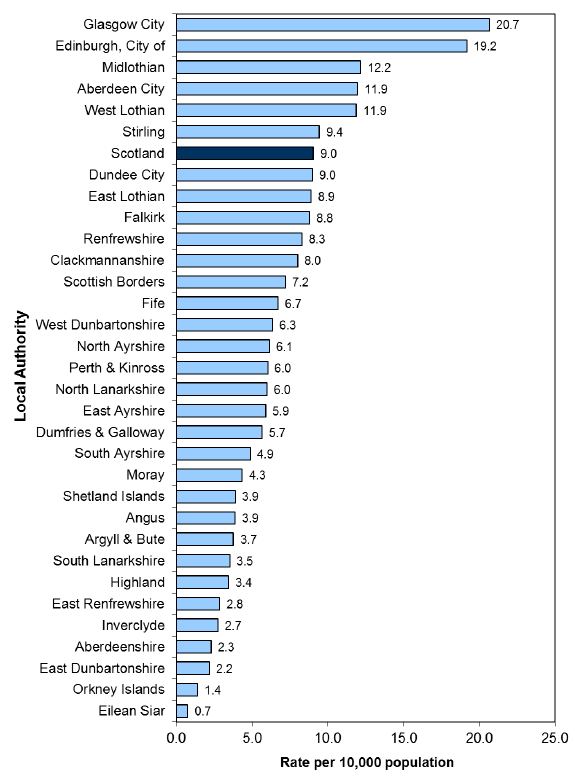
3.2. Detail of the incidents
Various details were recorded in relation to each racist incident, such as the location where the incident took place, the date and time of the incident, and whether a crime was recorded as part of the incident.
Chart 3: Location of racist incidents, Scotland, 2013-14
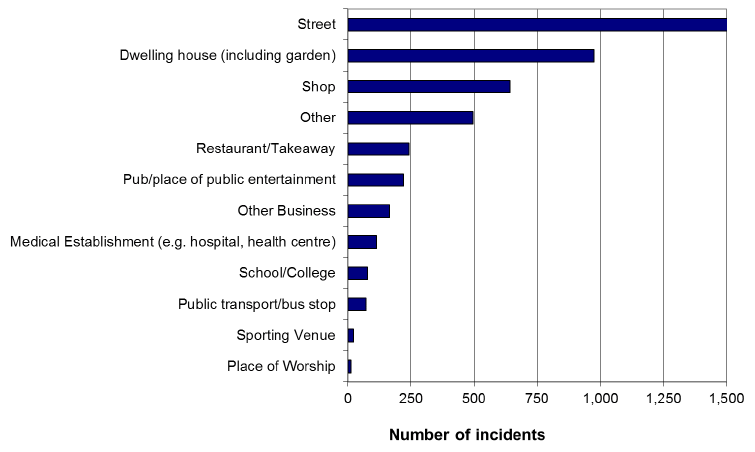
The most common locations (excluding 61 incidents where location was unknown) for an incident in 2013-14 were the street (36.0%), a dwelling house (20.5%) and in a shop (13.5%) (Chart 3 & Table 3).
In 2013-14, just over half of all racist incidents (51.1%) were recorded between Friday and Sunday, with the remaining 48.9% spread fairly evenly throughout the other four days of the week. Chart 4 shows that racist incidents peak between 6pm and midnight on most days of the week. On Sundays, most racist incidents occur between midnight and 6am (Table 5).
In 2013-14, where the person making the initial report about the incident was known, over two thirds (69.6%) of incidents were reported to the police by the victim/complainer. The police were responsible for reporting 12.7% of incidents and a further 10.6% of incidents were reported by a witness (Table 6).
Chart 4: Racist incidents by weekday and time, Scotland, 2004-05 to 2013-14
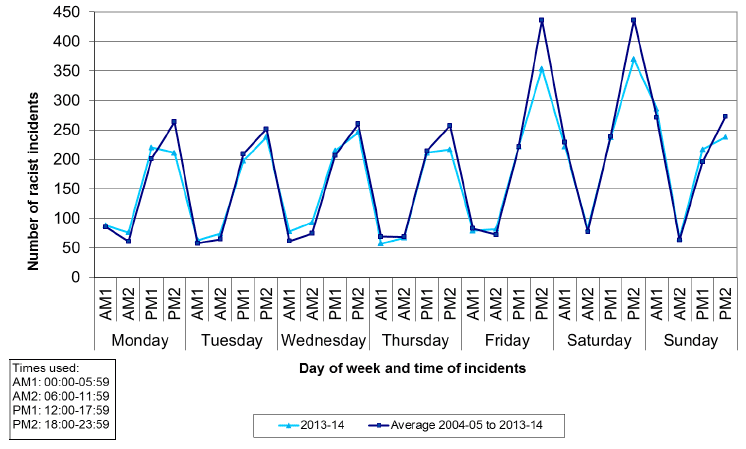
3.3. Crimes and offences recorded
In 2013-14, 94.7% of racist incidents recorded by the police resulted in at least one crime being recorded. A total of 5,520 crimes were recorded as part of racist incidents in 2013-14, a 5.6% increase on the 5,228 crimes recorded in 2012-13 (Table 1).
In 2013-14, the crime or offence most frequently recorded as part of a racist incident was 'racially aggravated conduct', which accounted for 47.8% of all crimes recorded. Other crimes or offences recorded as part of a racist incident included 'breach of the peace etc.' (28.1%), 'common assault' (12.3%) and 'fire-raising, vandalism etc.' (3.8%) (Table 7A).
In 2013-14, these four crimes and offences accounted for 92.0% of all crimes and offences recorded as part of a racist incident, similar to the 91.8% in 2012-13 (Table 7A). Definitions of 'racially aggravated conduct' and 'racially aggravated harassment' are included in section 6.16.
Overall, 77.0% of all crimes recorded by the police as part of a racist incident in 2013-14 were cleared up. The clear-up rate varies depending on the crime recorded as part of the incident, with the most common crimes recording clear-up rates of 83.8% (for 'racially aggravated conduct') and 73.4% (for 'breach of the peace etc.').
Due to the delay in collecting the data for 2013-14 (see section 2.6), it is not possible to calculate how much of the increase in clear up rates between 2012-13 and 2013-14 is due to a real-terms increase, as opposed to Police Scotland having more time to investigate and analyse 2013-14 incidents before submitting data to the Scottish Government than for 2012-13 incidents (Table 7B). It should be noted that previous years' clear-up rates are not revised to reflect continuous police investigation work. They are a static snap-shot based on when the data is collected.
The definition of 'clear-up rate' can be found in section 6.20.
3.4. Victims/complainers of racist incidents
The victim/complainer is the person who perceived the incident to be racist and the complainer may not necessarily be the person(s) at whom the racist incident was targeted and hence they may have different characteristics (e.g. different ethnic background). Data on the characteristics of victims/complainers should therefore be treated with caution.
In 2013-14, where the ethnicity of the victim/complainer was known, those with a 'Pakistani' ethnic background were the most likely to be the victim/complainer of a racist incident recorded by the police with 224.2 victims/complainers per 10,000 population. This was followed by 'African, Caribbean or Other Black' with 189.9 victims/complainers recorded per 10,000 population. The Scottish average across all ethnic backgrounds was 10.6 victims/complainers per 10,000 population (Table 8A).
When looking at the proportions of victims/complainers, 27.2% were of a 'White British' ethnic background (which includes 'White Scottish' and 'White English'). 'Pakistani' ethnic background accounted for 21.2% of incidents, 'Other White' (which includes 'White Polish' and 'White Irish') accounted for 14.0% and 'African, Caribbean & Other Black' ethnic background accounted for 13.1% (Table 8A).
Seven legacy police forces (covering 57% of racist incidents in 2013-14) were able to provide a more detailed breakdown of ethnic background for victims/complainers. This limited breakdown shows that 'Scottish White' is the largest ethnic group amongst victims/complainers. Further details on this detailed ethnicity classifications can be found in section 5.2 and Table 8B.
Where age and gender were known, 70.2% of victims/complainers of racist incidents recorded in 2013-14 were male. This compares with 71.2% in 2012-13.
When looking at the rate of incidents per 10,000 population, males were more likely to be a victim/complainer of a racist incident with 14.5 victims/complainers per 10,000 population, compared to 5.8 victims/complainers per 10,000 population for females. Males aged 26-35 had the highest rate with 38.8 victims/complainers per 10,000 population, while the corresponding highest rate for females, also aged 26-35, was 14.0 victims/complainers per 10,000 population (Chart 5 and Table 10).
Chart 5: Rate per 10,000 population of victims/complainers* and perpetrators of racist incidents, by age and gender of victim/complainer*, Scotland, 2013-14
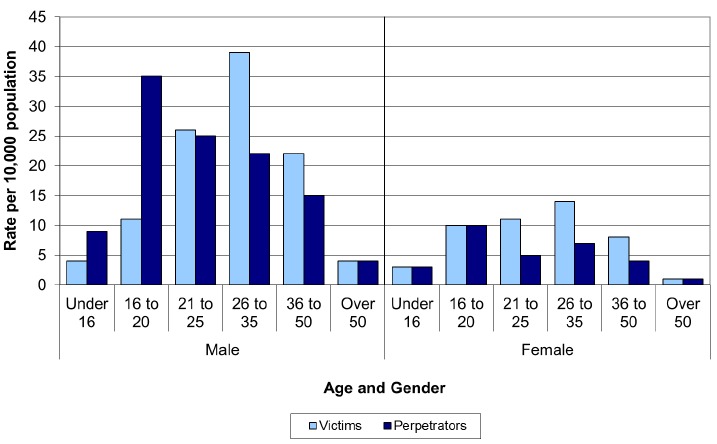
*The victim/complainer is the person who perceived the incident to be racist. The complainer may not necessarily be the person(s) at whom the racist incident was targeted. See section 2.7 for more info.
In 2013-14, 68.1% of incidents had information on whether the victim/complainer had ever reported a previous racist incident or whether this was their first time of reporting a racist incident. More details on the areas which were able to provide this information is included in section 6.29. Of the victims/complainers where information on repeat reporting is known, 71.1% were reporting a racist incident for the first time (Table 11).
3.5. Perpetrators of racist incidents
Information about perpetrators of racist incidents may only be fully available where the incident was resolved, and any crime involved has been cleared up (see section 6.20 for definition of cleared up).
Where information on the ethnic group of perpetrators was available, in 2013-14, 90.4% of perpetrators were of 'White British' ethnic background (which includes 'White Scottish' and 'White English') and 4.9% of perpetrators were of an 'Other White' ethnic background (which includes 'White Polish' and 'White Irish') (Table 12). Further details on the ethnicity classifications used can be found in sections 5.2.
Where age and gender was known, 13.2% of perpetrators in 2013-14 were under the age of 16 years. This is a decrease from 2012-13, when 20.8% of perpetrators were under the age of 16. As they were under the age of 16, they were therefore eligible for referral to the Scottish Children's Reporter Administration (SCRA) rather than the Procurator Fiscal (Table 14).
Males accounted for over three quarters (77.3%) of perpetrators of racist incidents recorded by the police in 2013-14. This has remained fairly stable for the past ten years with percentages fluctuating between 77.3% (recorded in 2013-14) to 79.6% (recorded in 2009-10) (Table 14).
When looking at the rate of incidents per 10,000 population, males were more likely to be a perpetrator of a racist incident with 13.0 perpetrators per 10,000 population, compared to 3.6 per 10,000 population for females. Males aged 16-20 had the highest rate with 35.2 perpetrators per 10,000 population, while the corresponding highest rate for females, also aged 16-20, was 10.0 perpetrators per 10,000 population (Table 14).
Where the action taken by the police was known, 81.3% of perpetrators in 2013-14 were referred to the Procurator Fiscal or SCRA. No further action was taken against 7.1% of perpetrators (Table 15).
Due to the delay in collecting the data for 2013-14 (see section 2.6), it is not possible to calculate how much of the increase in those referred to the Procurator Fiscal or SCRA between 2012-13 and 2013-14 is due to a real-terms increase, as opposed to Police Scotland having more time to investigate and analyse 2013-14 incidents before submitting data to the Scottish Government than for 2012-13 incidents (Table 15).
Chart 6: Action taken against perpetrators of racist incidents, Scotland, 2004-05 to 2013-14
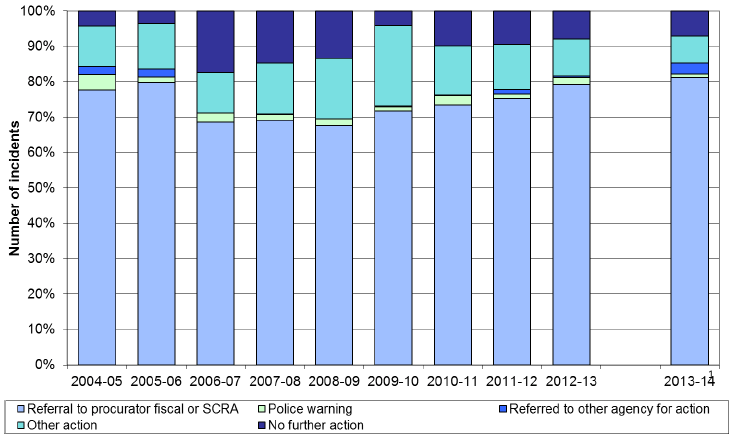
* Due to the delay in collecting the data for 2013-14 (see section 2.6), care is urged when comparing across years.
Contact
Email: Alan Sloan
There is a problem
Thanks for your feedback